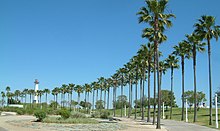Washingtonia (genus)
| Washingtonia | ||||||||||||
|---|---|---|---|---|---|---|---|---|---|---|---|---|

|
||||||||||||
| Systematics | ||||||||||||
|
||||||||||||
| Scientific name | ||||||||||||
| Washingtonia | ||||||||||||
| H. Wendl. |
Washingtonia is a North American genus of palm . They are also known as petticoat palms or Washington palms. The two species are often used as ornamental plants in the arid subtropics.
features
The representatives are showy, solitary tree-shaped fan palms . They are hermaphroditic and bloom several times. The trunk is erect and mostly partially or completely covered with the remaining dry leaves. The trunk is densely covered with ring-shaped leaf scars.
The number of chromosomes is 2n = 36.
leaves
The leaves are fan-shaped (costapalmat), folded induplicate and remain on the plant after they have died (marzescence). The leaf sheath has a conspicuous abaxial cleft below the petiole. The edges disintegrate into a dark brown fibrous network. The petiole is long, flattened to slightly concave on the upper side, rounded on the underside, the edges are reinforced with curved teeth. Towards the distal end, the teeth become smaller and more distant. The hastula on the underside is large, membranous, triangular with an irregular edge, the hastula on the underside is a low elevation that is covered by thick hairs in Washingtonia robusta .
The leaf blade is about one third irregularly divided into segments. The segments are simply folded, linear, bifid (two-part) at the top, and drooping when aged. The threads between the folds are noticeable. The central ribs stand out clearly on the underside.
Inflorescences
The inflorescences are between the leaves (interfoliar), are ascending, curved, slender and three-fold (up to four-fold) branched. They are as long as or often longer than the leaves. The peduncle is short. The cover leaf is tubular, with a tightly fitting sheath, two-keeled, and irregularly torn at the tip. At the peduncle there is a bract , this is similar to the cover sheet, but is einkielig. The inflorescence axis is much longer than the stem. The bracts here are tubular at the base, then torn lengthways. They become flat and sword-like, at the same time cartilaginous. The following bracts are small or missing entirely. There are numerous flower-bearing side axes (rachillae) that are short, very slender and bare.
blossoms
The flowers are hermaphroditic, are single, elongated, are in a spiral arrangement and have short stems. The calyx is tubular with three irregular, imbricate tips; it remains on the fruit. The crown is tubular to a third of the length, the free tips are valvate , narrow oval, bent back at the flowering time and thin. The six stamens are at the mouth of the corolla tube, the filaments are long and narrow from a fleshy base. The anthers are long, medifix, pliable, and latrors. The gynoeceum consists of three carpels , the basal free sense, connected in the long, slender stylus . The ovule is basal, erect, and possibly anatropic.
Fruits and seeds

The fruits are small, broadly ellipsoidal to spherical and often fall off with the fruit stalk and the calyx tube, which is torn open on one side. The fruit is blackish, the scar remains and the undeveloped carpel are apical. The exocarp is smooth and thin, the mesocarp is thin, fleshy with a few flattened longitudinal fibers. The endocarp is thin, crust-like, not connected to the seed and smooth inside.
The seed is ellipsoidal, somewhat compressed, with a basal, eccentric umbilicus (hilum). The raphe stretches over two thirds of the shiny red-brown seed coat. It is branched laterally. The endosperm is homogeneous. The embryo is basal.
distribution
The home of Washingtonia are the desert oases in the southwestern United States and northwestern Mexico . Washingtonia filifera occurs in southeastern California , western Arizona, and Baja California ; Washingtonia robusta in Baja California and Sonora . They are desert palms along rivers and canyons, but also near springs in the open landscape.
Systematics
The genus Washingtonia H. Wendl. is placed within the family Arecaceae in the subfamily Coryphoideae , tribe Trachycarpeae . However, it cannot be assigned to any subtribe within the tribe. The monophyly of the genus has not yet been investigated.
The Royal Botanic Gardens, Kew's World Checklist of Selected Plant Families recognizes the following species:
- California Washington Palm ( Washingtonia filifera (Rafarin) H. Wendl. Ex de Bary )
- Mexican Washington Palm ( Washingtonia robusta H. Wendl. ).
Washingtonia was first described by Hermann Wendland in 1879 , the type species is Washingtonia filifera (Linden ex André) H. Wendl. (= Pritchardia filifera Linden ex André ). The generic name honors the first President of the United States, George Washington .
A synonym of the genus is Neowashingtonia Sudw.
The genus is unknown to fossil.
supporting documents
- John Dransfield, Natalie W. Uhl, Conny B. Asmussen, William J. Baker, Madeline M. Harley, Carl E. Lewis: Genera Palmarum. The Evolution and Classification of Palms . Second edition, Royal Botanic Gardens, Kew 2008, ISBN 978-1-84246-182-2 , pp. 285-287.
Individual evidence
- ↑ Rafaël Govaerts (Ed.): Washingtonia. In: World Checklist of Selected Plant Families (WCSP) - The Board of Trustees of the Royal Botanic Gardens, Kew . Retrieved March 24, 2012.


